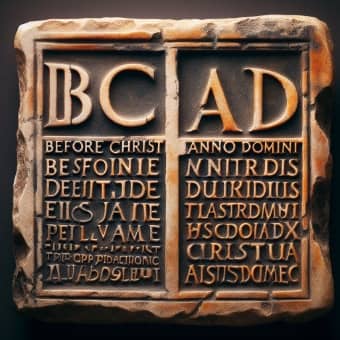The Meaning Behind BC and AD
Understanding Historical Time Markers
The terms “BC” and “AD” are widely used to denote time periods in historical and modern contexts. But what do they actually mean, and how did they come to be such a standard part of our calendrical system? To understand this, let’s delve into the origins and meanings of BC and AD.
This blog post contains affiliate links. When you click on a link on this page and make a purchase I may earn a small commission, at no additional cost to you. Thank you for your support.

BC – Before Christ
“BC” stands for “Before Christ.” It is used to indicate the years before the birth of Jesus Christ, the figure who stands central to Christianity. This system of numbering years was adopted because of the profound impact that the life and teachings of Jesus had on the world, particularly in the realms of religion and ethics.
The use of “BC” started in the early Middle Ages, conceived by Dionysius Exiguus, a monk who, in the year 525, sought to pinpoint the date of Easter. In the process, he introduced the system of years “before Christ” to identify the years prior to what he believed to have been Jesus’s birth.
However, historians today believe that the actual birth of Jesus occurred a few years earlier than Dionysius’s calculations—somewhere between 6 and 4 BC.
AD – Anno Domini
On the flip side, “AD” stands for “Anno Domini,” which means “In the Year of Our Lord” in Latin. This denotes the years following the traditional birth year of Jesus. The idea was to continue the calendar from the supposed date of Christ’s birth onwards. Thus, this system positions Jesus Christ’s birth as a central point in the calendar.
AD years are numbered from the traditionally recognized year of the birth of Jesus onwards. The year directly following 1 BC is AD 1. There is no year “0” in this system. Therefore, the year AD 1 immediately follows the year 1 BC.
Uncover the Tapestry of Human History
Embark on an epic journey through time with World History: Patterns of Interaction. This comprehensive textbook delves into the rich tapestry of human civilization, from ancient empires to modern global interconnectedness. Gain a deeper understanding of historical events, cultures, and the factors that shaped our world.
Perfect for students, teachers, and curious minds alike, this book offers a captivating exploration of the human experience.
Expand your knowledge of the world and its history with World History: Patterns of Interaction. Order your copy today and unlock the secrets of the past.
The Adoption and Usage of BC and AD
Throughout the Middle Ages and into the Renaissance, the use of AD became more widespread. It was particularly bolstered by its use in the writing of history by Bede, a notable historian. As Christianity spread throughout Europe, so did the use of the AD system, embedding it into the temporal framework of Western cultures.
BC and AD have been used in Christian majority societies and countries with Christian calendars. However, not everyone has embraced these systems. Since they reference Christianity explicitly, other non-Christian cultures and communities have preferred alternative dating systems that are either rooted in their own religious traditions or are secular.
Common Era – BCE/CE
To create a more universal calendrical system, some have adopted the terms “BCE” for “Before Common Era” and “CE” for “Common Era.” These terms correspond precisely to BC and AD, respectively but do not have explicit religious connotations. Especially in academic, historical, and international contexts, BCE and CE are used to foster inclusive communication.
Conclusion
The BC and AD system has been pivotal in the way history is segmented and understood. It provides a culturally recognized means to reference time in relation to a significant event—the traditional birth of Jesus—as perceived by Christian scholars.
However, it’s essential to recognize that as society aims to be more diverse and inclusive, parallel systems like BCE and CE become valuable and frequently adopted alternatives. As we move forward, understanding these terms not only helps us navigate historical timelines but also reflects the ongoing evolution of human society and its approach to capturing the sweep of time.
Read my blog post about The Life and Teachings of Jesus Christ.
Thank you for visiting my Moody Catholic blog. If you enjoyed reading this article please tell others by clicking on the share button in the lower right hand corner, right underneath the scroll to top arrow.


